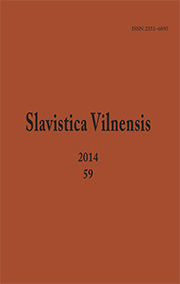Квазиоппозиции в текстах и грамматиках XVI–XVIII вв. как маркеры устройства славянской категории одушевленности
Quasi-Oppositions in the XVI-XVIIIth Century Texts and Grammars as Markers of Slavic Animacy
Author(s): Inna VernerSubject(s): Christian Theology and Religion, Historical Linguistics, Western Slavic Languages, Eastern Slavic Languages, 16th Century, 17th Century, 18th Century, Philology, Translation Studies
Published by: Vilniaus Universiteto Leidykla
Keywords: animacy; Slavic grammars; Slavic translations; Dmitry Gerasimov; Maximus the Greek; Pierre Statorius; Beneš Optat; Petr Gzel; Václav Philomathes; Jan Blahoslav; Matouš Benešovský;
Summary/Abstract: This article examines the paradigmatic expression of animacy in the XVI–XVIIIth century Russian, Polish, Slovak and Czech languages. In Russian, animate nouns are marked only by neutralization of the Acc. and the Gen. forms, whereas in Czech, the differentiation of animate and inanimate nouns is marked primarily by different case endings for a single grammatical case. Polish and Slovak use both methods. Some texts and grammars from the early development stages of the modern Slavic literary languages reflect the creation of certain artificial oppositions. These quasioppositions are present in Dmitry Gerasimov’s and Maximus the Greek’s translations of the Church Slavonic Donatus, in the first Polish grammar by Pierre Statorius (1568), in the Czech grammars by Beneš Optat, Petr Gzel and Václav Philomathes (1531), Jan Blahoslav (1571) and Matouš Benešovský (1577), as well as in the Slovak Camaldolese Bible (1756-59).
Journal: Slavistica Vilnensis
- Issue Year: 59/2014
- Issue No: -
- Page Range: 81-94
- Page Count: 14
- Language: Russian

